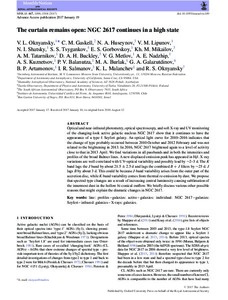The curtain remains open: NGC 2617 continues in a high state
V. L. Oknyansky; C. M. Gaskell; N. A. Huseynov; V. M. Lipunov; N. I. Shatsky; S. S. Tsygankov; E. S. Gorbovskoy; Kh. M.Mikailov; A. M. Tatarnikov; D. A. H. Buckley; V. G. Metlov; A. E. Nadzhip; A. S. Kuznetsov; P. V. Balanutza; M. A. Burlak; G. A. Galazutdinov; B. P. Artamonov; I. R. Salmanov; K. L. Malanchev; R. S. Oknyansky
The curtain remains open: NGC 2617 continues in a high state
V. L. Oknyansky
C. M. Gaskell
N. A. Huseynov
V. M. Lipunov
N. I. Shatsky
S. S. Tsygankov
E. S. Gorbovskoy
Kh. M.Mikailov
A. M. Tatarnikov
D. A. H. Buckley
V. G. Metlov
A. E. Nadzhip
A. S. Kuznetsov
P. V. Balanutza
M. A. Burlak
G. A. Galazutdinov
B. P. Artamonov
I. R. Salmanov
K. L. Malanchev
R. S. Oknyansky
OXFORD UNIV PRESS
Julkaisun pysyvä osoite on:
https://urn.fi/URN:NBN:fi-fe2021042716726
https://urn.fi/URN:NBN:fi-fe2021042716726
Tiivistelmä
Optical and near-infrared photometry, optical spectroscopy, and soft X-ray and UV monitoring of the changing-look active galactic nucleus NGC 2617 show that it continues to have the appearance of a type-1 Seyfert galaxy. An optical light curve for 2010-2016 indicates that the change of type probably occurred between 2010 October and 2012 February and was not related to the brightening in 2013. In 2016, NGC 2617 brightened again to a level of activity close to that in 2013 April. We find variations in all passbands and in both the intensities and profiles of the broad Balmer lines. A new displaced emission peak has appeared in Ha. X-ray variations are well correlated with UV-optical variability and possibly lead by similar to 2-3 d. The K band lags the J band by about 21.5 +/- 2.5 d and lags the combined B + J filters by similar to 25 d. J lags B by about 3 d. This could be because J-band variability arises from the outer part of the accretion disc, while K-band variability comes from thermal re-emission by dust. We propose that spectral-type changes are a result of increasing central luminosity causing sublimation of the innermost dust in the hollow bi-conical outflow. We briefly discuss various other possible reasons that might explain the dramatic changes in NGC 2617.
Kokoelmat
- Rinnakkaistallenteet [27094]
